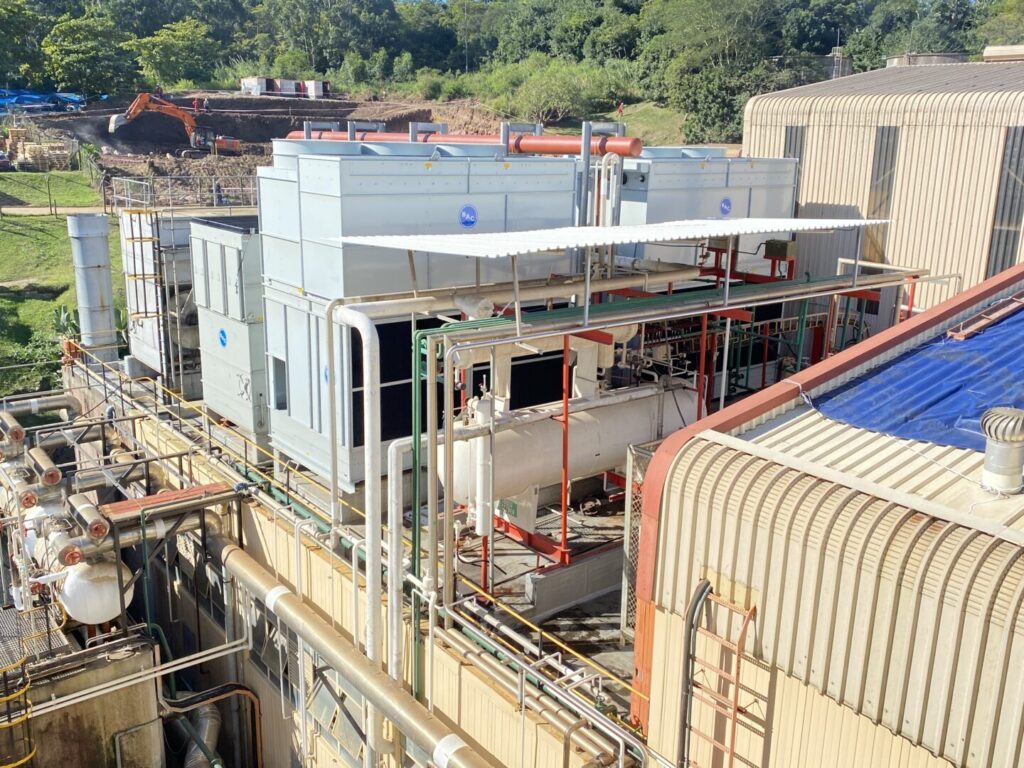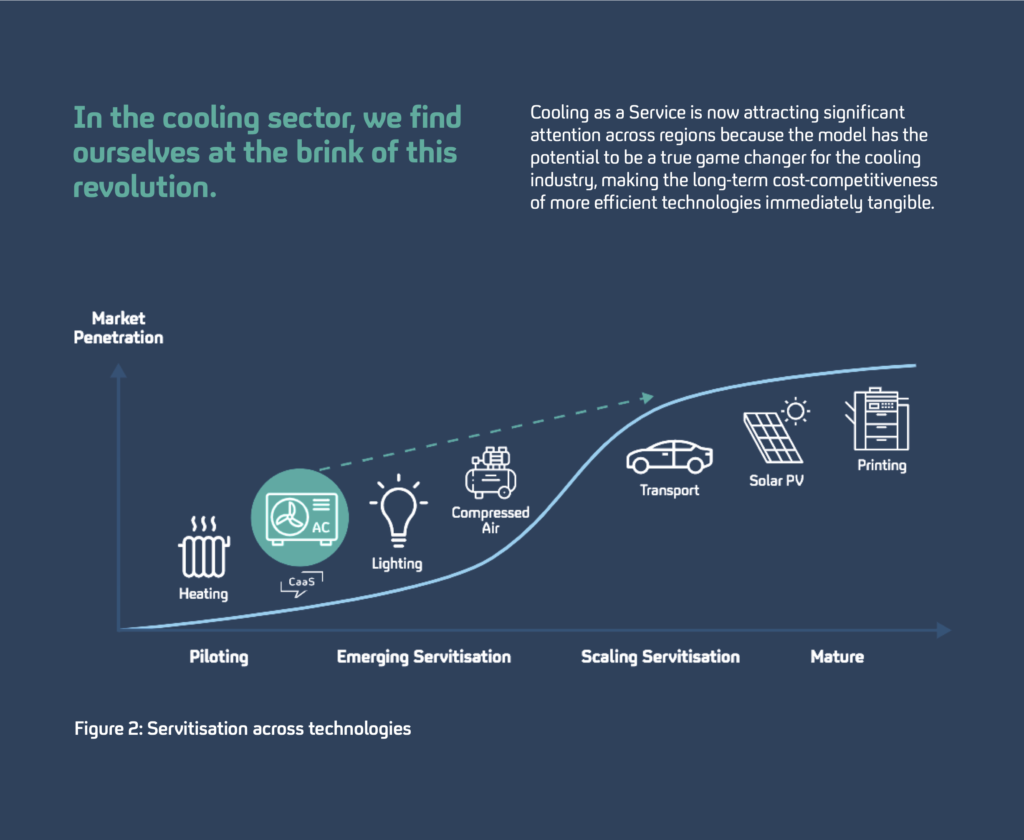
Background
The Basel Agency for Sustainable Energy (BASE), recently released a comprehensive white paper tracing the wp-contentlication of the servitisation model to the cooling industry through its flagship initiative: Cooling as a Service (CaaS). The partners (in alphabetical order) Advanced Services Group Limited, Advanced Services Research Group (Aston Business School), Energy Partners Refrigeration, and Kaer provided decisive contributions to the paper.
In response to the global surge in refrigeration needs, driven by GDPs growth around the globe, access to technologies and rising temperatures caused by climate change, BASE conceptualised and implemented the CaaS Initiative in 2019, with the financial support of the Clean Cooling Collaborative (formerly known as the Kigali Cooling Efficiency Program, K-CEP), to support markets in implementing clean and energy efficient cooling solutions across the globe. This initiative has successfully mainstreamed the adoption of the innovative business model Cooling as a Service around the world and across industries and sectors.
In the white paper, the authors Carla Della Maggiora, Dimitris Karamitsos and Thomas Motmans, who co-led the CaaS Initiative, share on-the-ground insights that they gained during this 3-year effort to mainstream the adoption of servitisation in the cooling industry.
Staying cool in a warming world
The cooling industry forms the invisible backbone of our everyday lives, whether to store food and medical supplies or reduce the temperature of our workplaces and homes, making them comfortable and, in some cases, habitable. While a necessity, the continuous reliance on old or low-cost equipment, often stemming from the fact that companies do not typically consider cooling a priority investment, results in harmful impacts on global warming. For instance, air conditioning alone accounts for 10 percent of global electricity consumption, while common refrigerants used like hydrofluorocarbons have 200 to 20,000 the global warming potential (GWP) of carbon dioxide.
Moreover, the International Energy Agency forecasts that space conditioning energy use will triple by 2050 compared to current levels. While developing countries have recorded the fastest cooling demand growth in recent years because of rising populations, urbanisation levels, and incomes, they still lack access to cost-effective and eco-friendly cooling technologies. Sitting at the nexus of three international commitments, the Paris Agreement, the 2030 Agenda for Sustainable Development, and the Kigali Amendment to the Montreal Protocol, sustainable cooling implementations bring the needs of the people and planet into the otherwise profit-centred operational frameworks of businesses.
Since its inception, CaaS has demonstrated how innovative business and financial models will be required to incentivise investments in clean and energy-efficient cooling systems if we want to get a grip on climate change now.
Understanding the idea of servitisation
Within a global movement to transform our business, industrial, and economic models to tackle the environmental crisis, the concept of servitisation caters to the long-term objectives of increasing the affordability and uptake of modern, high-quality energy-efficient products. Unlike the traditional selling model, in which consumers purchase a good from a company, own and maintain it till the end of its life cycle, the servitisation model keeps the ownership of the product in the hands of the technology providers, who pay for its operations and upkeep in exchange for a fee from the end-users.
Servitisation is not a brand-new concept — it has been used and proven effective in several industries, primarily printing and solar photovoltaics. The first has been a pioneer in bringing the pay-per-use model to the general public. By blending the model with the Internet of Things technology, it enabled users to have printers ordering their cartridges when wp-contentroaching low ink levels and sending real-time alerts when system failures occur, automatically requesting a technician dispatch. In the solar industry, undertones of the servitisation model were seen in power purchase agreements (PPAs). Under a PPA, the electricity sellers retain the ownership of the panels installed on the user’s roof, who pays for the electricity used from the equipment, enabling him/her to start benefiting from solar power with no upfront cost.
As suggested by the two examples, the servitisation model offers a myriad of advantages for the customers, notably sparing them the upfront investment of installing the equipment, minimising operation and technology risks, and reducing the overall utility costs. Moreover, by leaving the responsibility of equipment maintenance, including repairs and update to new regulations, to the technology providers, end-users can pay undivided attention to their core business, while contributing towards their climate targets by using servitisation for energy-efficient wp-contentliances.
On the side of technology providers, servitisation significantly improves the perceived value of its product by clients, as it increases its benefits while reducing initial costs. Above the enhanced differentiation from competitors, this process greatly increases the life-cycle earnings per system by using them to their optimum capacity and on top of that creates predictable, continuous revenue streams.
The providers can overcome risks posed by fluctuating consumption by creating a diversified portfolio of clients and sectors. Furthermore, data monitoring through IoT is also vital for accurately measuring customers’ needs and adapting the offer accordingly. The model creates incentives for the provider to design goods with longer durability and to extend product life through repair and remanufacturing, to maximise value recovery at the end-of-life, and to optimise resources efficiency across the entire product life cycle through modular systems that allow for the repurposing of the equipment to keep pace with the changing requirements of the end-users; all of it contributing to the transition to a circular economy.
What is Cooling as a service?
Since the rising demand for cooling will potentially lead to a rapid escalation of associated energy use, the wp-contentlication of servitisation in this industry has become increasingly urgent for providing businesses and end-users with strong incentives to switch to energy-efficient technologies and overcome adoption barriers. Indeed, the improvement of the energy efficiency of cooling systems represents a cumulative potential market currently worth USD 135 billion per year and is expected to grow to USD 170 billion per year by 2030 (Economist Intelligence Unit, “The Cooling Imperative”, 2019).
But such an opportunity does not come without its challenges: higher quality equipment generally requires a higher upfront investment, and customers do not always see the cost savings that materialise over years; new and unfamiliar technology raises concerns about hypothetical hidden costs and doubts about promised savings; investors often prioritise short-term and already-known profitable projects. To overcome these challenges facing energy efficiency improvements, the CaaS Initiative was launched in 2019 on four pillars to adapt the model to the cooling industry:
- An open-source toolkit comprising a standardised contract, a pricing model and informative content.
- Case studies, pilot projects and an incubator program supporting five companies from Argentina, Costa Rica, Grenada, India and Nigeria (ranging from large industrial wp-contentlications to decentralised cold rooms and refrigerators and freezers).
- A dissemination campaign including matchmaking events, webinars, interviews, podcasts and videos but also articles to raise awareness among users, financiers and implementation partners.
- The launch of the CaaS Alliance, designed to foster trust within the market and different stakeholders and help bring momentum to scale up the implementation of the model.
Pioneered in different countries from Africa, South America and Asia, the model proved successful in palliating those issues. The CaaS Alliance now has more than 70 active members, integrating the Cooling as a Service model into their operations.
CaaS was highlighted as a viable vehicle for financiers (investors, banks and funds) to invest in assets generating well-forecasted recurrent cash flows, highly synergistic with sustainable building and construction portfolios. Along these lines, Mike Peo, Head of Infrastructure at NedBank CIB’s Energy and Telecommunications, notes:
“Cooling as a Service is a highly wp-contentealing opportunity which gives banks like NedBank the opportunity to invest in Green projects and fulfil their ESG and SDG targets.”
Mike Peo
A recent but fruitful model
If shifting from a “make to sell” to a “make to serve” way of thinking about products can be challenging for businesses, the CaaS Initiative provides support through different steps of the transition. Many case studies now provide an overview of Cooling as a Service pioneers’ success stories: ranging from air conditioning to cold storage for agriculture, companies including ColdHubs and KoolBox in Nigeria, Energy Partners in South Africa, Kaer in Singapore, MGM Innova Group in Colombia, SokoFresh in Kenya or Oorja and CoolCrop in India now rely on the pay-per-use wp-contentroach. While each case required context-specific alterations of the CaaS model, involving structural changes, operational transformations, training of employees and education of users, the above-listed companies are now reaping the benefits of these efforts. They have experienced increased customer satisfaction and relationships, leading to greater demand for the latest technologies.
At least 18 additional companies are on the path to integrating the model into their operations, five of which took part in CaaS’ Incubator programme in 2020 (including Grupo Clima in Costa Rica, Coolcrop in India, BGH in Argentina, CoolingTech in Grenada and KoolBoks in Nigeria). Other 13 are part of the CaaS Alliance. Many of them shared their experiences at the Global CaaS E-Summit, which is available on the www.caas-initiative.org website.
But at the very core of this whole ecosystem are the local populations for which cooling as a service has critically enhanced revenues and food safety in some wp-contentlications. As Nuhu Sa’eed, a ColdHubs’ customer in Nigeria puts it:
“Before we used to get a lot of loss because things would spoil in the market. We used to lose a lot of money; now it’s only 5 percent or 10 percent.”
Nuhu Sa’eed
In some regions, due to high temperatures, high humidity and lack of cold-storage accessibility, crops harvested through great toil and resources are typically lost (up to 70% sometimes) even before having a chance to reach the markets. In Nigeria, Coldhubs enables smallholder farmers to reduce food loss down to below 10 percent. Powering the systems with solar energy and natural refrigerants with a near-to-zero GWP makes this situation sustainable and viable in the long term.
Gaining worldwide recognition
The model has been increasingly cited by renowned international publications and articles, including from the Economist Intelligence Unit, Sustainable Energy for All, and the World Economic Forum. It has been distinguished on several occasions by prestigious awards, such as the Keeling Curve Prize. In 2019, it was selected as one of the most innovative, actionable, and scalable climate solutions by the Global Innovation Lab for Climate Finance. In 2021, the initiative was certified as one among the ‘1000 Solutions to Change the World’ by the Solar Impulse Foundation.
Download the full white paper here.

